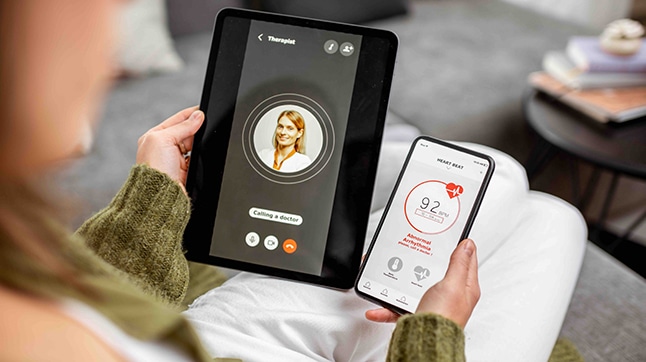16 April 2020
How the COVID-19 Pandemic is Fast-tracking Digital Transformation in Telehealth

What is Telehealth
Telehealth is a system that allows patients to receive high-quality healthcare services from the comfort of their own homes via the use of telecommunication technology. Telehealth services normally consist of a smart hub that allows patients to enter their personal health data, including vital signs, either manually or automatically via the use of various medical devices, such as blood glucose monitors, pulse oximeters and blood pressure readers. The data collected is then sent to either a non-clinical or clinical monitoring service that monitors the patient’s health or alerts the appropriate health provider.
Who benefits from Telehealth services?
A Telehealth system is particularly useful for patients with long-term health conditions, patients who live in remote areas, or for patients who are self-isolating during the current coronavirus pandemic. Telehealth technology can improve patient access to specialist healthcare services while eliminating the need to travel for medical advice, therefore allowing patients to remain more independent, self-manage their conditions and limit the strain on GP and primary health services. Telehealth systems can also offer education and peer support services to health professionals while providing patients with mentoring and coaching services via a series of questions and answers.
How COVID-19 has fast-tracked the healthcare system
Before the coronavirus outbreak, there was a degree of progress in Telehealth technology, but the pandemic has lead to renewed evidence of the value of Telehealth, as public health officials are encouraging healthcare providers to expand their Telehealth services to smartphones and other tools to make them more accessible.
Telehealth technology is helping to reduce the strain on public health services by virtually communicating with patients and triaging them, reducing widespread panic by assuring patients that they do not possess any of the coronavirus symptoms and are not required to visit already overcrowded hospitals. Telehealth technology also has the benefit of limiting human contact and preventing the spread of the virus.
New tools and technologies in Telehealth services such as live video consultations are proving to be a huge asset to healthcare providers to connect patients with doctors while remaining isolated. Other services such as instant messaging for therapy services, secure emails for ongoing communications and informed telephone consultations are also proving to be useful.
Other promising tools include the use of chatbots and symptom trackers to interact with patients and refer them for in-patient care, as their technology is designed to evolve as more information is gathered about the coronavirus. Medical tricorders and home monitoring is another promising approach to at-home patient care. Currently used in the management of certain chronic health conditions, remote patient monitoring uses consumer devices such as smart TVs and smartwatches to provide remote examinations.
The COVID-19 pandemic has created renewed awareness of the benefits of Telehealth services and is bringing them to the frontline of patient care, which is expected to reshape the future of public health services.
How Opmantek can improve healthcare efficiency
Opmantek’s Network Management Information System (NMIS) is designed to monitor the performance of an organisation’s data network. It can be used to monitor device health and bandwidth. It can be used to resolve issues before they become problems and provide valuable information for planning infrastructure changes.
With the renewed awareness of the benefits of Telehealth, an efficient and patient-driven online healthcare system is becoming essential. Opmantek’s Network Information Management System can streamline digital outputs for hospitals and make them more efficient to improve patient care. Adding Opmantek’s commercial software provides additional insights and automation capabilities through to performing traffic analysis better enabling bandwidth management. And for a truely large scale operation the distributed polling capabilities to improve scalability.
opFlow
Opmantek’s opFlow, is designed to gather network insights to analyse the network. For instance it can with location of attack vectors and pick up on network errors so that they can be resolved quickly, leading to reduced downtime for everyone including hospital networks.
For more information about how Opmantek’s products can help you set your business or healthcare organisation on the path to digital transformation, get in touch with our team of experts today.